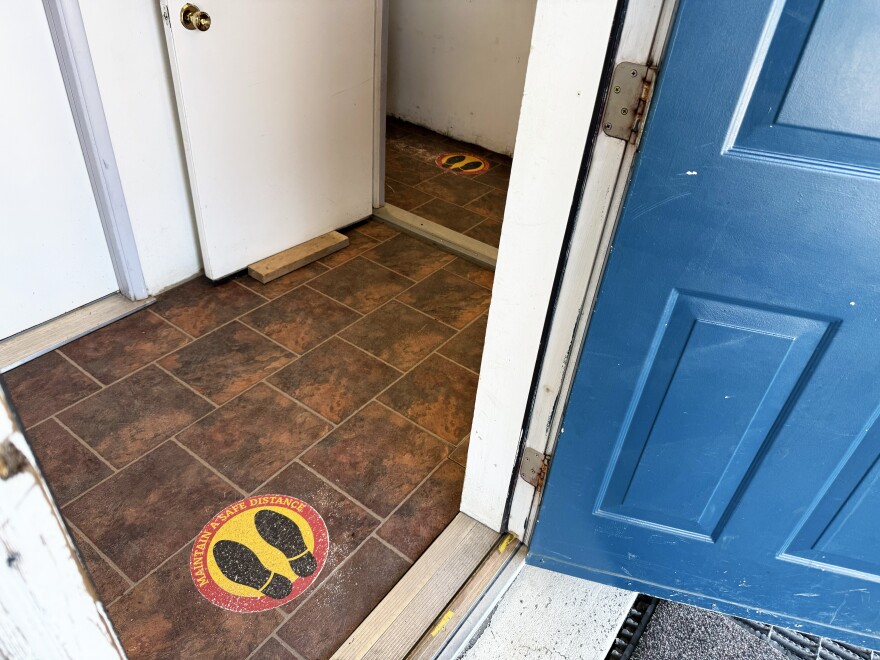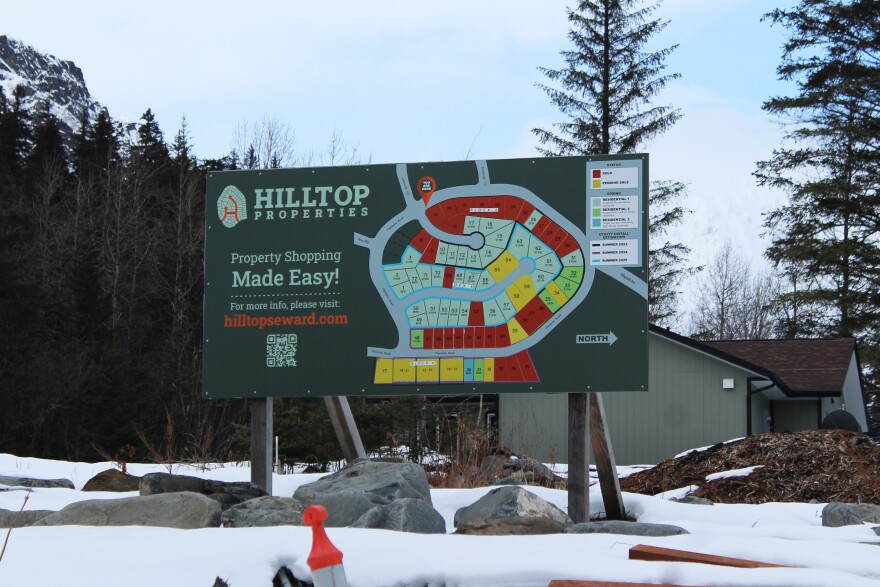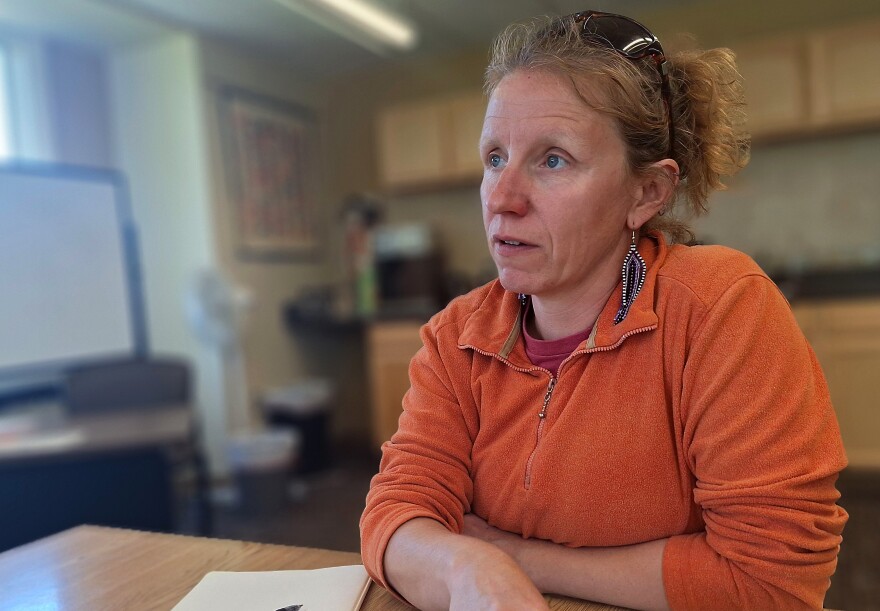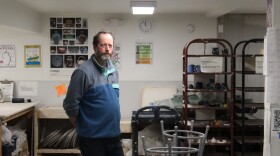Throughout the COVID-19 pandemic, Kenai Peninsula governments were instrumental in distributing federal relief dollars to their citizens. From awarding grants to businesses and nonprofits, to migrating public meetings online, public sector employees were tasked with translating federal legislation into material benefits for Kenai Peninsula residents. In this next installment of “What a Relief,” KDLL peeks behind the curtain at the municipal forces that helped pump tens of millions of dollars into borough communities.
There’s a path of circular stickers leading from the front door of Seldovia’s municipal building to the front desk. They’re dandelion yellow, overlaid with black shoe prints. A crimson outline says “Maintain A Safe Distance.” The stickers are placed six feet apart, and are well worn from years of foot traffic.
To get to Heidi Geagel’s office, follow the stickers to the back of the building. Geagel is Seldovia’s city manager, but during the COVID-19 pandemic, she was the city clerk. Sitting at her desk, she clicks through files on her computer screen.
“We did issue a disaster declaration, a local disaster declaration, on March 20, 2020, and the declaration activated the city emergency response plan, as well as allowed a vehicle for those funds to come into the city,” she said.
She’s talking about the federal COVID-19 relief dollars distributed to cities. Seldovia got about $300,000 in direct aid from the CARES Act – including through the state and borough – and another $66,000 from the American Rescue Plan Act.

Throughout the pandemic, local governments were a key middleman for distributing money to their communities. The CARES Act designated $150 billion specifically for state, local and tribal governments. The American Rescue Plan released another $350 billion for the same effort.
Seldovia spent CARES Act money on small business grants, residential utility relief and the city’s senior meals program. ARPA funds went to grant-writing services and to renovating the city council chambers. They bought a new computer, speakers, cameras, microphones and tablets that replaced paper packets to accommodate remote participation in city meetings.
For all of the pandemic’s downsides, Geagel says public engagement with city meetings shot up – city council watch parties stick out in her memory. That’s why she says she laughed when someone asked her when the city would return to in-person-only meetings.
“I was like, ‘No, once you open that door, that's – there's no going back,’” she said. “You've provided that accessibility to the public, and you can't, you can't take that away.”
In 2025, peninsula residents still participate in city council, borough assembly and school board meetings using Zoom. But it hasn’t always been a given that’d be the case.
The Kenai City Council, for example, has waffled on whether to phase out remote participation in city meetings. The city’s been so-called “Zoom bombed” by hackers on more than one occasion. But members have consistently determined it’s in the public interest to keep allowing remote participation.
City Manager Terry Eubank says the city’s internal processes went digital, too.
“We went from, I think, having two departments online with electronic timesheets to the entire city online in less than 30 days,” he said.
Eubank was Kenai’s finance director during the pandemic. He says COVID relief funds were released at a time when Kenai was bearing the brunt of larger financial challenges.
“As the state of Alaska starts experiencing its budget issues and its budget shortfalls and reduction in revenues, the first thing it starts falling off of that table is the grants to local governments,” he said.
He says the city’s always been financially sound. But at the onset of the pandemic, the city was reevaluating its ability to keep up with projects, like repaving roads and maintaining facilities. For the first time in Kenai’s history, Eubank says they were considering implementing a seasonal sales tax. Then the COVID money came.
The city used CARES Act funds to pay wages for public safety employees and replace the city’s lost revenue. They rolled out small business grants, made improvements to Kenai’s outdoor spaces and launched a grocery incentive program. And the city banked money it saved by using pandemic relief funds for eligible operations. Since then, they’ve spent the savings on capital projects.
“I think for us, what it really did was bought us some time and allows us to look at our revenue growth, work on other areas of revenue growth, whether that's through, you know, new development in the city, or whatever it is,” he said. “And we haven't had to make any harsh or rash decisions regarding mill rates or anything else.”
Infrastructure investment was also a priority for Seward. City Manager Kat Sorensen says the $4.8 million the city received through the American Rescue Plan facilitated the city’s biggest success story.

“A lot of these COVID funds were used to address our two main problems,” she said. “The first was child care … but the other one is housing in Seward and the availability of land.”
Just under $1 million went to a development reimbursement program. Another chunk funded design work for a new public works building. And some more went to expanding city utility lines.
Seward was also the home port for Norwegian Cruise Line, which gave the city a $1 million donation in 2021. Sorensen says the city usually brings in about half a million dollars from taxes on cruise ship passengers. But Seward didn’t get any cruise ships in 2020 or 2021. So the cruise line stepped in to try and offset some of that financial hardship.
In Soldotna, city council member Lisa Parker says resident relief was her priority when considering where to target relief funds.
“For Soldotna, the greatest financial impacts were going to be on businesses,” she said. “And so when you look at how, in 2020, we got almost $10 million in federal funds, and when we looked at distribution of those funds, we decided that it was important to give it back to people.”
The city got $7.4 million through the state of Alaska, and another $2.6 million from the Kenai Peninsula Borough. City staff and council members created the SOLDOTNA CARES program, which distributed almost three million dollars to small businesses and nonprofits.
Parker says the thinking there was simple.
“It was important to give it back, to share and to care,” she said. “I mean, it was the CARES Act.”
SOLDOTNA CARES sent money to the Kenai Peninsula Food Bank, to community mental health services and to Central Peninsula Hospital. Another program helped businesses build outdoor dining areas to promote social distancing, and the city worked with the Alaska Housing Finance Corporation to help pay residents’ rent.
With a little over one million dollar in American Rescue Plan funds, she says they focused on economic recovery. Some went to pay for design work on the Soldotna Field House, while another chunk went to developing an arts and culture master plan.
“I think about the things that we've done here in Soldotna now, and the vision and the plans that we have going forward, you know, we want to continue to have a community that is vibrant,” she said.
Rachel Lord was also a city council member during the pandemic. Now, she’s the mayor of Homer. She remembers the process of distributing relief funds as chaotic.
“We wanted to try to capture that chaos to the benefit of the community as much as humanly possible, and also stay on the right side of it by the end, because we're accountable for it, right?” she said.
She said council members faced bureaucratic hurdles trying to act quickly at the onset of the pandemic. The cogs of government are notoriously slow. But emergency declarations issued by Homer – and other cities on the Kenai Peninsula – helped speed things up.
“If you want to spend $6,000 you have to have an ordinance,” she said. “… You have to wait two weeks to have a public hearing and second reading. It is not conducive to responsiveness.”

The government’s handling of the pandemic could be politically divisive. Lord remembers taking heat from constituents about the council’s decision to close city playgrounds and the city’s installation of doors to restrict traffic through city hall.
But she says the city worked closely with the local hospital and public health center, and deferred to recommendations from the U.S. Centers for Disease Control and Prevention.
“We as a city are not qualified to be like, ‘Actually, we don't think the CDC is right in this instance.’ Like, based on what?” she said.
Looking back, Lord says she views the pandemic as a sort of turning point, after which society moved into a “very black-and-white space.” But as a council member, she says they were doing their best to understand the ground they were standing on as it shifted beneath their feet.
Overarching the city’s individual efforts was the Kenai Peninsula Borough, which received $37 million through the CARES Act. That’s about a fifth of what it will take to run the borough this fiscal year.
All told, the borough and its six incorporated cities brought in more than $50 million of direct appropriations from the CARES Act and ARPA.
The borough spent about $720,000 moving meetings to Zoom and retrofitting the assembly chambers for remote participation. Other money reimbursed Central Peninsula Hospital and emergency personnel wages, while more propped up six new communications towers and funded an absentee vote-by-mail campaign ahead of the 2020 election.
In 2025, social distancing floor stickers are less common than they were when, say, put down in Seldovia’s city building. But a smattering of more impactful, albeit not always as obvious, traces of pandemic linger in the landscape of municipal governance, if you know where to look.
This was the second installment in a new reporting series by KDLL called “What a Relief,” which looks at the impact and legacy of federal COVID-19 relief funds distributed to the Kenai Peninsula. Tomorrow, we hear from nonprofit organizations about how the influx of money helped keep programs running and doors open. This reporting project is supported by the Alaska Center for Excellence in Journalism.




